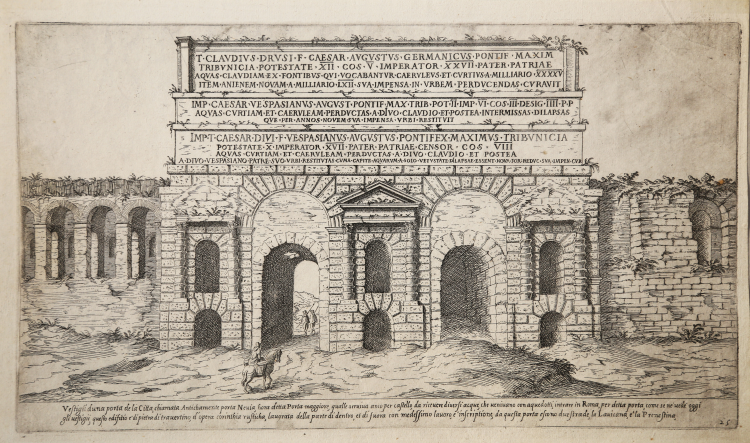



| Reference: | s7375 |
| Author | Etienne DUPERAC |
| Year: | 1575 |
| Zone: | Porta Maggiore |
| Printed: | Rome |
| Measures: | 380 x 215 mm |


| Reference: | s7375 |
| Author | Etienne DUPERAC |
| Year: | 1575 |
| Zone: | Porta Maggiore |
| Printed: | Rome |
| Measures: | 380 x 215 mm |
View taken from the work I vestigi dell'antichità di Roma raccolti et ritratti in perspettiva da Stefano Du Perac parisino, published for the first time in Rome in 1575 by Lorenzo Vaccari.
The volume consists of forty plates: the first serves as a frontispiece; the second contains the dedication to "Giacomo Buoncompagni governator generale di Santa Chiesa". Étienne Du Pérac expresses his intentions and in particular emphasizes that "the book [...] will therefore be useful and grateful, and accepted by scholars of antiquity for the diligence I have used in faithfully representing the remains of Roman grandeur". He then relies on the "authority and virtue" of the dedicatee so that he can encourage the work "in need of much light" because of the "obscurity of the author".
When he published the book, Étienne du Pérac had been in Rome for more than fifteen years, and was known, if only for having supplied his work to the Veronese scholar Onofrio Panvinio and for having printed in 1574 the archaeological map Urbis Romae Sciographia, a topographical reconstruction of ancient Rome, which would be followed, in 1577, by the map of modern Rome, the Nova urbis Romae descriptio. Certainly the market of antiquarian publishing was quite crowded: in the same year 1575, for example, another Frenchman, the printer Antonio Lafreri (Antoine Lafréry), with whom Du Perac also collaborated, published the iconographic collection Speculum Romanae Magnificentiae, which brought together, engraved by various artists, many more images than I vestigi, not following a topographical approach and not limiting himself to ancient buildings but including modern ones as well as a repertoire of statues.
Here Du Pérac, starting from the Capitol, outlines his itinerary in thirty-nine stages: at the bottom of each page a caption of a few lines provides essential information about the buildings and ruins. However, these are not representations of individual monuments, nor ideal reconstructions, but real views: images of great quality, comparable to those published in 1551 by the Flemish engraver Hieronymus Cock.
Etienne Du Pérac or Duperac, born in Bordeaux or Paris, soon moved to Venice, where he learned the art of engraving by making various subjects from Titian, mainly for the publisher Giovanni Francesco Camocio. He arrived in Rome in 1559 where he devoted himself to the study of architecture and antiquities, with particular attention to the works of Michelangelo. In Rome he knows Onofrio Panvinio, archaeologist and antiquarian, who influences him and introduces him to the study of Roman antiquities. As all the artists coming from Northern Europe, he remains fascinated by the majesty of the Roman ruins, deciding to study and represent them. The previous representations of the monuments of Rome, for example those made by Hieronimus Cock around 1550, were pictorial and enriched with fantasy elements. The remarkable importance of the views of Rome by Duperac lies in the fact that they were represented with absolute archaeological and topographical precision, so as to be studied today with great attention by scholars of archaeology, since they often represent monuments and sites now lost.
The work had 8 subsequent editions, some by the De Rossi printing house.
Copper engraving, in excellent condition.
|
Robert Dusmenil, Peintre Graveur Francais, vol. VIII, pp. 92-99, 1-40; Reed & Wallace, Italian Etchers of the Renaissance & Barocque, p. 83,84.
|
|
Etcher, engraver, painter and architect, from Bordeaux. Active in Venice and from 1559 in Rome.Returned to France either in 1578 or 1582. Died in Paris.
Duperac worked for various Roman print dealers, including Lafreri, Vaccari ,Faleti and P.P. Palumbo.He himself published some of his own work.Specialized in antiquities,maps and views.
Urbis Romae sciographia ex antiquis monumentis accuratiss. Delineata,1574.
Also the series,Vestigi dell’antichità di Roma ,1575.
|
|
Robert Dusmenil, Peintre Graveur Francais, vol. VIII, pp. 92-99, 1-40; Reed & Wallace, Italian Etchers of the Renaissance & Barocque, p. 83,84.
|
|
Etcher, engraver, painter and architect, from Bordeaux. Active in Venice and from 1559 in Rome.Returned to France either in 1578 or 1582. Died in Paris.
Duperac worked for various Roman print dealers, including Lafreri, Vaccari ,Faleti and P.P. Palumbo.He himself published some of his own work.Specialized in antiquities,maps and views.
Urbis Romae sciographia ex antiquis monumentis accuratiss. Delineata,1574.
Also the series,Vestigi dell’antichità di Roma ,1575.
|